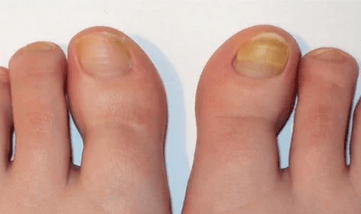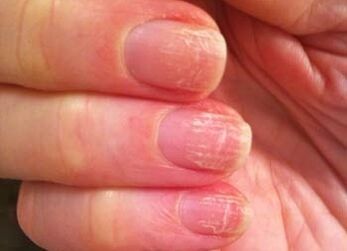
Fungi, called fungal diseases in everyday life, have infectious nature and are easily transmitted in contact with an infected person, animal or object.
Once found on the skin or nail plate, the fungus begins immediately to eat tissues on which it appeared, gradually arranging more and more area.With the enzymes, the fungus decomposes the keratin, which is part of the tissues of the skin, hair and nails, that is, it destroys them.
Nail fungi at the initial stage only differ in a less notable event.But the disease is homogeneous throughout the course of the course and the basis of the treatment used.
How the nail fungus begins: symptoms and photos
The onset of nail fungus cannot always be observed as its manifestations can be insignificant.
The possible symptoms of this disease are as follows:
- Changing the color of infected areas, often yellowing.
- the disappearance of nail gloss.
- the appearance of relief points, points or strips on the nails.
- thickening, main, fragility or peeling infected areas.
- Partial destruction of the nail along the edges and skin over the nail.
- itching or pain in infection.
- An unpleasant odor of nails.
The phenomena mentioned can be both symptoms of fungal and consistency of other factors, for example, as follows:
- lack of vitamins and minerals;
- accumulation of dead skin or dirt.
- injuries;
- taking some medicines.
- Non -infection: diabetes, psoriasis, eczema.
Thus, for an accurate diagnosis of fungal infections, even in the presence of symptoms, a laboratory analysis of the affected nail plate fragment is necessary.
Symptoms of the original nail fungus in hands: Photo

Nail fungi in the hands is a bit less common than in the legs.
His events are the same:
- stench;
- Itching and pain.
- Atrophy of the nail plate and skin on it.
- Change in shape and color of the nail plate.
- Loss with flashing nails and a change in their color.
The same symptoms may indicate the following factors:
- Inappropriate nutrition
- Great contact with detergents or chemical reagents
- By taking certain medicines
- Some diseases of non -infectious nature.
Methods to treat the original nail fungus
It is necessary to treat fungal infections, as this not only destroys the appearance of the hands or feet, but also leads to reduced immunity.As a result, people with fungus on the nails are more prone to colds, influenza and other infectious diseases.
Any way of dealing with nail fungus must necessarily include measures to prevent repetition.With the affected tissues, the fungus falls on clothes, shoes and other objects in which the patient touches with his fingers or legs.
Therefore, the following rules must be followed:
- Infected shoes used before treatment starts, heal by special means or throw away.
- Before full recovery, wear cotton socks.
- Do not use slippers except those that are easy to wash (with a smooth inner surface).
- Change socks and gloves to clean each day and are used to wash at high temperature and iron.
- It is advisable to deal with shoes with ultraviolet antifungal investments throughout treatment.
According to professional medicine representatives, nail mycose even at the initial stage requires systematic treatment at first and outside in the second.The choice of drugs is made according to the type of existing fungus.Laboratory tests can determine it.
- Systematic agents anti -inflam or antimicocys.They accumulate on the nails and scales of the skin of the skin.The penetration of the fungus into cells, the active ingredients of the drugs destroy their membrane or stop the synthesis of the substances with which it feeds.As a result, the fungus dies.The treatment should take at least 3 months according to the following figure: one week of admission, a three -week break.So repeat twice.After that, for another six months, the drug will exist in the tissues affected by the fungus.So a healthy nail will have time to grow, and the fungus will not apply to it.The rest of the treatment methods are used in addition to systemic treatment.Using only local exposure methods can cure the infection for some time, but in this case there is a risk of relapse.
- Antifungal drugs of local use.These drugs soften in the consistency of nails affected by plastin.This effect allows you to easily remove the nails affected by the fungus, accelerates the growth of the new nail and increases the effectiveness of systemic drugs.Antifungal factors are produced in the form of varnishes or ointments.The affected nails are covered with varnish and applied to the top of cosmetics.
- Medical pedicure.This method is the removal of tissue tissue affected by a fungus and soft nail and feet with a special tool with many nozzles.The procedure lasts from 15 minutes to 2 hours and is performed 1 - 2 times a month.The duration of treatment is from 3 months to one year.Medical Pedicure is performed in specialized offices.It not only treats the infection, but also improves the appearance of nails.After the first process, they look much better.And the signs of recovery are noticeable in the first 3 weeks of treatment.
- Oszonotherapy.The introduction of ozone into soft tissues near the nails reduces inflammation into them and increases local immunity.The course of treatment is at least 10 procedures that occupy up to 20 minutes each.Held 1 - 2 times a week.
- Traditional medicineIt offers the following method of treatment of nail fungus.The following sequence of actions must be performed daily for at least 3 months or until the recovery is completed.In the evening before you go to bed, steam your feet or hands (depending on the position of the infection) in a solution of 50 degrees.On each nail of the affected limb, apply cotton wool, well -saturated with hydrogen peroxide or apple cider vinegar.Close the foot (brush) with cellophane plastic wool or glue them with a patch and go to bed.Throughout the treatment period, cut the nails according to the needs, as usual.
Prevention
Sources of infection with fungi are:
- Public places where they go without shoes: baths, saunas, shower, sports halls, beaches.
- Public items: shoes (more often slippers), gloves (for example, boxing).
- Carpets, more often in bathrooms.
- The animals, including domestic, and the wool that have fallen from them.
- terrain.
In order to minimize the likelihood of infection, it is necessary to observe hygiene rules:
- If possible, avoid contacts with sources of infection, especially wearing common shoes and clothes
- Don't wear tight shoes
- Apply ultraviolet antifungal investments for cohabitation shoes with a person suffering from fungus.
You should be aware that fungi can come to life after several months of staying in a dried state.
The risk factors that are not surprised are heredity and slow nail growth.The fungus is easier to spread through a slow -growing nail.The rate of growth decreases with age.
Immunity in this disease does not play an important role, since in the nail area it is much smaller than in most body systems.
Professional medicine successfully treats fungi, both at the initial stage and after that.However, it is not possible to get rid of this disease without treating a specialist.



























